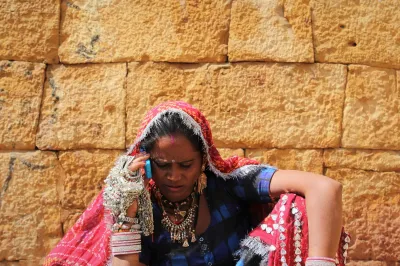Branchless Banking Gains Momentum in India
Over the past several months, we have taken a close look at the branchless banking industry in a few key countries. We have presented our learning from Brazil and Mexico over the last few weeks. Today we offer a snapshot of the conditions for branchless banking in India drawn from a summary note of the Indian scene completed at the end of 2010.
India has embarked on far-reaching financial inclusion initiatives by opening up regulations to allow the use of agents (called Business Correspondents in India) since 2006. India is also building new public infrastructure which could inject a further boost. Will these conditions deliver a lasting increase in financial inclusion?
The government is making visionary investments in public infrastructure.
Allowing the use of banking agents is common today, yet India has moved even further ahead beginning to build 3 pieces of public infrastructure that could substantially accelerate financial inclusion:
- A mobile payments switch: To take full advantage of the banking network across India, public-private collaboration has built the Inter-bank Mobile Payment Service (IMPS). This new switch allows mobile phone-initiated transactions to pass from the bank account in one bank to an account at another bank. If fully leveraged across the banking network, it would counteract some of the barriers posed by India’s size and regionally fractured banking presence.
- Unique identification: The Unique Identification Authority of India has begun to roll out registration of the unique identification number with matching biometrics. As this becomes more widely available, it could ease KYC processes and reduce the friction of mass branchless banking operations.
- Shifting government subsidies to electronic payment systems: The 2012 budget announced a plan to shift some public subsidies (such as $12.5 billion in fertilizer annually) to a system where payments will be delivered directly into the beneficiaries’ accounts. This change would funnel large payments volumes through branchless banking and, among other benefits, bring clients into a deeper banking relationship. This recent policy shift adds to ongoing state efforts to transfer National Rural Employment Guarantee Act wage payments electronically.
A diverse range of nonbank players are developing last mile delivery capabilities.
A range of nonbanks have begun to build technology and distribution networks to extend banking services over vast distances. The earliest entrants were technology firms that also built networks of retail agents such as FINO, Eko, A Little World and Nokia/Obopay. These firms have thus far been the most innovative early entrants into the space.
Mobile network operators (MNOs) have been keen to enter this space, although only since September 2010 have regulations permitted them to play a direct role. At least 3 of India’s largest MNOs – Airtel, Vodafone, and Idea—are pursuing larger roles in the delivery of financial services in partnership with various banks.
More recently fast moving consumer goods (FMCG) companies such as Hindustan Unilever, Bayer CropScience and ITC have begun to examine the potential to add financial services to their distribution networks. A range of NGOs are also engaging in this line of work.
Nevertheless, the large banks remain in the driver’s seat.
While supportive public infrastructure and agent networks are fast developing, regulation has placed commercial banks in the most influential role in the service delivery equation through a combination of policies:
- Customer Ownership: Several regulations ensure banks retain a lead role in client relationships. Agent locations must be branded to a single bank and only the banks are permitted to levy fees on the end clients.
- Links into public infrastructure: Only banks can participate in IMPS, and G2P transfers generally require end beneficiaries to receive the payments through a bank account.
- Issuance of e-money: Prepaid regulations ensure that only banks can offer fully open prepaid accounts that are redeemable. This and other policies effectively bar nonbanks from issuing e-money.
- Large existing branch networks are favored: Agent locations must be within 30 km of the bank’s branch, limiting the ability of smaller banks from using agents to expand their footprint.
The banks have begun to address the key challenges.
- While nonbanks will play important roles, the weight of the responsibility to deliver lies with India’s banks. It is too early to judge success, but we can be confident that if banks succeed they will have addressed key hurdles. Motivation: A visit to the branches of most banking outlets in India reveals organizations which generally avoid small value transactions and poor clients. Indian banks have done comparatively well with an estimated 45% of adults with access to the formal system, but there is a long way to go.
- Meeting customer needs: Product design, service and marketing can’t be transferred from existing clients to low income ones. Time and again, we have standard banking products fail when applied to low income segments. Approaches will need to be re-fashioned, tested and tailored requiring significant resources and creativity.
- Transaction volumes and revenues: A common challenge of most branchless banking services is slow uptake by clients and painfully lagging revenues. The sooner revenues can be generated, the greater confidence we can have that the expansion will be lasting.
Where should we look to get an early indication of bank progress?
The number of agent locations and accounts will be spiking upwards in India in the coming months as banks stretch to meet their March 2012 targets. But in order to track whether lasting progress is being made, we should look beyond basic volume targets to whether the underlying business is beginning to work:
- Agent network quality: turnover of agents, ample liquidity and service interruption
- Client uptake: transaction volumes per client, use of multiple products
- Revenue generation: revenues by product and market segment, data on willingness to pay
Banking officials and policymakers are investing more and more time in building the branchless banking business. There will be much to learn from India in the coming years.
For more detailed information on branchless banking in India, read our country note here.
- Greg Chen




Comments
Indian Banks have been
Indian Banks have been aggressive in launching branchless banking services directly to the unbanked population unlike MPESA which in addition to starting with a single product went after a good customer segment that could use the MPESA services or saw value. Indian banks need to identify the right customer segments who can give them traction/adoption even if this is done with more than one product/service
Nice summary of systemic
Nice summary of systemic drivers in India. From a business operations perspective, India Banks & BCs would do well to take MPESA founder Nick Hughes’ recent advice at Sankalp Forum in Mumbai: Focus on one key value proposition, “Send money home” (P2P remittance). Forget other financial products until traction is gained later…
Add new comment